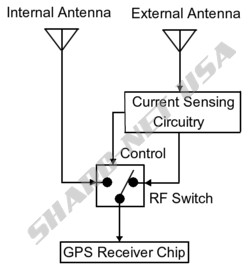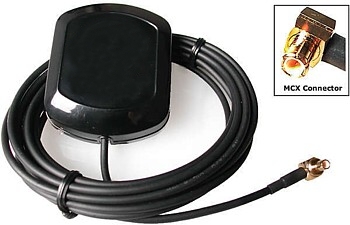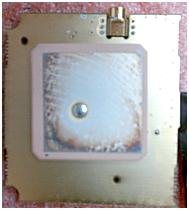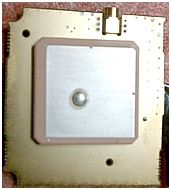 |
 WWW.SHARCNET-USA.COM WWW.GPSOBSESSION.COM |
 |
|
|
"Look Toto! We're not stuck in Kansas anymore!" Have you noticed that your GPS wasn't receiving as well as it used to? Were you driving down the highway and all all of a sudden your GPS says, "Lost Satellite Reception"? Even with a clear view of the sky and no matter what you do, you can't get any satellite reception? Does your GPS pick up signals each time you turn it on and flip up the internal antenna but then several minutes later all of the signals are gone? Do you see a repetitious cycle where the signals come and go and then come back again? Well, your not alone. These symptoms are a very common problem. We know what causes it and we know how to fix it. There are however, a few things that you can try in order to restore satellite reception on your own, before you consider sending your unit to us for repair. (G-Brand): Place your finger over the lower left-hand corner of the screen (upper left-hand corner for a 6xx series) and hold it there while pressing the on/off power button. Keep holding your finger there and a window should pop up asking if you want to go into maintenance mode. Select yes. There is an option called "clear user data". Select that option. It will not erase your favorites. It will however, erase any corrupted satellite data and will default you back to some factory settings and to a location of the manufacturer's headquarters in Kansas. This will also force your GPS to collect new satellite data. Your GPS should reboot and it will ask you a couple questions like, timezone, language. Please select the proper settings. Make sure the antenna is up and that you are outside. On the main screen, you will see a satellite bar graph in the upper left-hand corner. Touch the bar graph and you should get a satellite map, showing the satellites. If your GPS's receiver is working ok, you should see horizontal hollow bar graphs appear on the right. Eventually they will turn solid blue. This indicates that your GPS has downloaded the proper data from the satellite. When you have (4-5) solid blue horizontal bars (4-5 satellites), you will see the top panel begin to show improved accuracy and your GPS will then work as it should. If you don't see any bar graphs, your GPS may ask you several minutes later, if you are indoors. If your outside, select no. It will then ask you if you have moved 1000 miles since your last use (Remember, a factory reset makes your GPS think your in Kansas). Select "yes". This will cause your GPS to start looking for satellites, trying to locate your new position. This entire process may take 30 minutes or less. Now, if you still don't see any bar graphs, then your antenna/GPS receiver assembly may have a problem. There is an ESD (electrostatic discharge) issue that causes the GPS to no longer use its internal antenna. The failure causes the GPS to always look for signals at the external antenna port (the gold connector on the side of the GPS antenna). The problem is caused by either the failure of an internal RF switching IC or TVS diode located on the antenna/GPS receiver board.  If you have a piece of small wire (use just a single strand), a couple feet long, you can insert the wire into the center socket of the external antenna jack. Make sure that the wire isn't too big in diameter or you might damage or stretch the center socket. Make sure that the wire doesn't short to the outer ground shell of the connector as there is a +2.5VDC bias on the center conductor that powers an external pre-amplified antenna. Lastly, make sure you don't break the wire off inside of the center socket. If you can't find a single strand of wire, you can use a bread twistie tie wire. Orient the wire vertically. Most likely, you'll begin to see bar graphs after a few minutes and your GPS will lock. Now remove the wire. In most cases, the signals will go away in just a few seconds. It is possible that the unit may continue to receive signals once the wire has been removed but the problem will most likely come back again later on. If you still don't see a signal with the piece of wire, then most likely a component has shorted to ground, shunting all of the incoming RF signals to ground.  External GPS Antenna If the piece of wire works, rather than repairing/replacing the internal antenna/GPS receiver assembly, you can purchase an external antenna for your GPS. The external antenna is magnetic and can either stick to your roof or any metal surface within your vehicle. The antenna is supplied with 9ft of RG-174 coax and it plugs into the antenna jack located on the side of the flip-up antenna assembly. The antenna has a built-in 55 dB gain pre-amplifier and it will give you much better satellite reception than the internal antenna. In most cases, you will pick up more satellites and their signal strength will be much greater (usually full bars). The more satellites received, will result in greater accuracy. I was able to obtain accuracy within 8 ft, which is really quite good. SHARCNET-USA carries these antennas in stock. There is a disadvantage though. The external antenna receives its power from the Nuvi, so if your running on battery power, there will be a slightly greater drain on the battery. No need to worry though, if your powering the unit with the car adapter. Another problem that can cause loss of satellite reception, is if the GPS receiver has failed. If this happens, the only way to repair the problem is to replace the entire antenna/GPS receiver assembly. Here's how to tell if you may have this problem: (G-Brand): At the main menu, press on the "wrench" symbol. Then press the "gear" symbol and then press "about". There is a field marked "GPS S/W". There should be a number next to it. It may be "2.8", "2.9" or "3.0". The number tells you that the main board in the GPS is communicating with the antenna/GPS receiver assembly and has sucessfullly polled the firmware version from the GPS receiver chip. If you see "0.0" then your antenna/GPS receiver assembly is defective or the GPS firmware is corrupted and there's no way to repair it other than to try to reflash the firmware and if that doesn't work, then you'll have to replace the antenna/GPS receiver assembly. Another symptom of this problem is when you boot up the GPS, it will show a progress bar and say "GPS Software Loading" and then stop before the progress bar finishes. This problem is often referred to as the "ZOMBIE MODE" or "ZM". You bet we can! SHARCNET-USA carries a large inventory of replacement antenna/GPS receiver assemblies. These assemblies have been modifed to resolve any future Loss of Satellite Reception problems. Please click [HERE] to see our repair price list. When we repair your unit, it will continue to operate (switch) between the internal or an external antenna just as it did from the factory. Beware of websites that discuss jumpering the internal antenna to the external antenna port. This is NOT the correct way to resolve this problem. The jumper affects the circuit impedance, places a standing voltage on the internal patch antenna and will affect reception performance when an external antenna is plugged in, as both the internal antenna and external antenna will be shorted together. In addition, the REAL culprit to this problem is STILL in the circuit and DOES affect the incoming signal strength and receiver sensitivity. When the part is replaced, not only does it restore satellite reception using either the internal or external antenna but the signals will be stronger! This problem is NOT caused by "bad solder joints" as reported by another repair center. It's caused by a defective part. We find it extremely difficult to believe that a large GPS manufacturer would not know the right soldering temperature for their SMT ovens after producing many millions of units. The entire process is computer-controlled and they would surely have the settings right after running just a handful of boards. SMT part manufacturers also specify the correct soldering temperatures for their parts. It's not rocket science! Don't believe the bad solder joint(s) myth. That's just an exaggeration to make the problem seem more difficult than what it really is, so they can justify to charge you an outrageous price to repair it. The fact is, it's caused by a part failure. Also beware of those offering to sell antenna replacement services. The antenna assemblies that they are using in their repairs have the same circuit design issue as the original antenna, which can cause the replacement antenna to fail as well. Our antenna assemblies have modified with a part that has a higher rating than that of the original part. The manufacturer is aware of this problem and has revised the printed circuit board to accomodate a larger and more robust part. However, that doesn't help those with an older board revision. Unlike other service centers, we can repair this problem EVEN if your unit won't receive a satellite signal through the external antenna port. We install NEW aluminum tape with conductive adhesive shield covers on the repaired Antenna/GPS Receiver Assemblies. We don't salvage the old shielding covers, which may not seal well, once they have been removed. Good RF shielding is important. The antenna is silver-plated and over time, the silver-plating can oxidize. We remove the oxidation during the repair process. The oxidation doesn't affect reception but removing it makes the antenna look new again.
We also apply a very small amount of lithium grease to the flip-up axle. Over time, the silver paint on the axle rubs off (this happens on the end that goes into the rear case). When the paint wears off, there is plastic rubbing & scoring against plastic, causing friction and making the flip-up assembly tight and sometimes difficult to flip up. So, don't be misled by wrong or deceptive information. Don' take chances. Please allow me repair this problem for you......the right way. WARNING!!! Taking your GPS apart requires the right tools. There are internal flex ribbon cables for the antenna, touch screen and LCD screen. These cables are very delicate and can be torn easily if you're not careful. The antenna flex ribbon cable runs through the swivel antena shaft and is very delicate. In addition, these devices contain components that are very sensitive to static discharges and can be damaged without using the proper grounding techniques. Please do not attempt to make this repair yourself unless your are qualified to do so. We have received numerous emails from people who have gouged and cracked their GPS's case and permanently damaged their GPS's LCD screen and antenna! Save yourself the aggravation and possible damage to your GPS by allowing us to repair your GPS for you. Please feel free to fill out a Repair Request/Quote Form, which is located at the bottom of the left-hand menu. We'll be more than happy to discuss your GPS problem with you and attempt to offer a possible solution to have the problem resolved.
|
© Copyright SHARCNET-USA - All Rights Reserved
Images are property of their respective owners
This site is not affiliated with any GPS or Digital Camera Manufacturer
We are not a Factory Authorized Service Center








